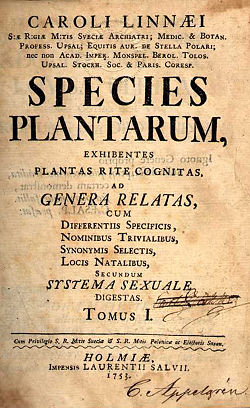Rank names
The main ranks are kingdom (regnum), phylum or division (divisio), class (classis), order (ordo), family (familia), genus and species. The ranks of section and series are also used in botany for groups within genera, while section is used in zoology for a division of an order. Further levels in the hierarchy can be made by the addition of prefixes such as sub-, super-, infra-, and so on.
Divisions such as "morph", "form", "variety", "strain", "breed", "cultivar", hybrid (nothospecies) and "landrace" are used to describe various sub-specific groups in different fields.
It is possible for a clade to be unranked, for example Psoroptidia (Yunker, 1955) and the SAR supergroup. Sometimes a rank is described as clade where the traditional hierarchy cannot accommodate it.
Latin descriptions of names or taxa
In zoology the English descriptions, such as "conserved name", for example, are acceptable and generally used. These descriptions can be classified between accepted names (nom. cons., nom. nov., nom. prot.) and unaccepted combinations for different reasons (nom. err., nom. illeg., nom. nud., nom. rej., nom. supp., nom. van.), with some cases in between regarding the use (nom. dub.: used but not fully accepted; nom. obl.: accepted but not fully used, so it yields precedence to a nom. prot).
- Candidatus (Ca.) – a taxon proposed from incomplete information, such as uncultured bacteria known from metagenomics
- ex errore – made in error
- incertae sedis – of uncertain placement
- nomen alternativum (nom. alt.; plural: nomina alternativa) – an alternative name, as for certain plant families
- nomen conservandum (nom. cons.; plural: nomina conservanda) – a conserved name
- nomen dubium (nom. dub.; plural: nomina dubia) (zoo. bact. bot.(informal)) – a name of questionable application [1]
- nomen ambiguum (plural: nomina ambigua), (bot.) a name that has been used with more than one meaning
- nomen confusum (plural: nomina confusa), (bact.) a name based on a mixed bacterial culture
- nomen perplexum (plural: nomina perplexa), a name confusingly similar to another name or names
- nomen periculosum (plural: nomina periculosa), a name which can lead to dangerous outcomes, through confusion
- nomen erratum (nom. err.; plural: nomina errata) – a name given in error
- nomen illegitimum (nom. illeg.; plural: nomina illegitima) – an illegitimate name
- nomen invalidum (nom. inval.; plural: nomina invalida) – an invalid name
- nomen manuscriptum – a name that appears in a manuscript
- nomen monstrositatum (nom. monstr.) – a name based on a monstrosity (fasciation, phyllody or similar deformities)
- nomen novum (nom. nov.; plural: nomina nova) – a replacement name
- nomen nudum (nom. nud.; plural: nomina nuda) – a name published without an accompanying description
- nomen oblitum (nom. obl.; plural: nomina oblita) – a name which has been overlooked (literally, forgotten) and is no longer valid
- nomen protectum (nom. prot.; plural: nomina protecta) – a name granted protection
- nomen rejiciendum (nom. rej.; plural: nomina rejicienda) – a name that has been rejected and cannot be used
- nomen subnudum (nom. subnud.; [2] plural nomina subnuda) – A species that was published with a description, but not detailed enough to describe it. Similar to nomen nudum. [3]
- nomen superfluum (nom. superfl.; plural: nomina superflua ) - "superfluous name" [4]
- nomen suppressum (nom. supp.; plural: nomina suppressa) – a name that has been suppressed and cannot be used
- nomen vanum (plural: nomina vana) – not a useful term, has been used to mean either a nomen dubium (see above in this list), or an invalid change in spelling, better called an unjustified emendation [5]
- nomina circumscribentia , a name derived from its circumscription
- partim , indicates that a taxon was split and contains only a part of the original entity. [6]
- species inquirenda , a species of doubtful identity requiring further investigation
This page is based on this
Wikipedia article Text is available under the
CC BY-SA 4.0 license; additional terms may apply.
Images, videos and audio are available under their respective licenses.
